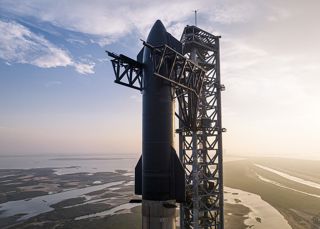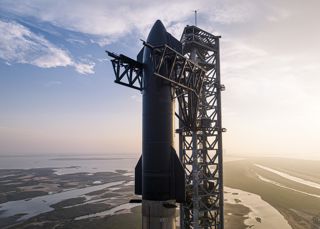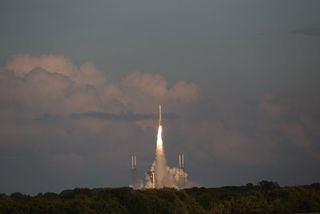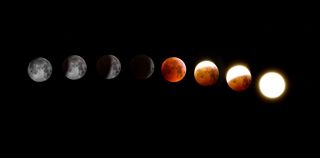
What's Happening in Space: September 2023
- 1st Sep 2023
- Author: Grace Davis
A summary of space events through the month
Dhara Patel is a Space Expert at the National Space Centre, working to help share space science, stories, and topical news with our visitors and online audiences. Each month she curates a round-up of some notable space and science events coming up the weeks ahead.
There some exciting events coming up in September, including conjunctions between the Moon and Jupiter, as well as the Moon and Saturn so it's time to get gazing!

2nd September – Aditya-L1 mission
Delayed from the end of August to early September and off the back of the success of the Chandrayaan-3 mission, the Aditya-L1 mission is the first space-based Indian mission dedicated to observing the Sun. It's scheduled to be launched aboard a PSLV-XL launch vehicle from Sathish Dhawan Space Centre in Sriharikota, India, on 2nd September. The spacecraft will be placed in a halo orbit around Lagrange point 1, L1, 1.5 million km from Earth (in the direction of the Sun) and will investigate space weather by observing the Sun’s corona and its influence on the Earth’s climate.
Following launch it will take around 109 days to reach L1 and when operational will use its four remote sensing payloads and three in-situ observation payloads to study the solar upper atmospheric (chromosphere and corona) dynamics. Its insight will hopefully provide a greater advantage of observing the solar activities and its effect on space weather in real time. You’ll find a blog on the Aditya-L1 mission on our website by the start of the month: https://www.spacecentre.co.uk/news/space-now-blog/
4th September – close approach / conjunction of the Moon and Jupiter
During the evening of 4th September, the waning gibbous moon will be in conjunction (sharing the same right ascension – coordinate) with Jupiter. But the pair will be below the horizon then so it won’t be possible to see them at that time. Instead wait until around 10:00pm when they will have begun to rise above the north-eastern horizon. At this time they will be in close approach and will remain neighbourly throughout the night until sunrise the morning after washes out Jupiter from view. You should be able to spot the Moon with Jupiter just to the right of it. Find out more about conjunctions and other astronomical phenomena in our blog written by David Southworth in our Education Team: Astronomical phenomena (spacecentre.co.uk).

8th September – Starship next test flight?
Following the first test flight of the fully integrated Starship rocket on 20th April 2023, SpaceX have been working on numerous design changes and are readying for a second attempt. Starship is made of the Super Heavy booster – a first stage rocket with 33 of SpaceX’s raptor engines and on top of that sits the upper stage, rather confusingly also called Starship, which hosts 6 engines. And when its fully developed it will be a completely reusable rocket – both first and second stages. Back in April the upper stage failed to separate from the booster a few minutes into its flight and SpaceX experienced a ‘rapid unscheduled disassembly’ aka explosion.
The FAA (Federal Aviation Administration) are yet to grant a license for this next Starship launch but the booster has been rolled out to the launch pad for a spin prime test (spinning up the turbopumps on the engines). If all goes well, we should soon see an all-engine static fire test a few days later where engines are ignited but the rocket does not launch. And then Starship (upper stage) could be moved to the launch site soon after for combined stack tests and eventually launch. Earliest launch dates are set for 8th September but this all rests on FAA approval. Find out more about Starship and SpaceX’s other rocketry achievements in this blog by Ed Turner in our Education team: https://www.spacecentre.co.uk/news/space-now-blog/spacex-the-world-s-rocket-giant/
15th September – new moon (2:39am)
The new moon on 15th will occur in the constellation of Virgo. We have a blog on ‘phases of the moon’ written by Mike Darch in our Space Comms team: What are the Phases of the Moon? (spacecentre.co.uk).
16th September – close approach / conjunction of the Moon and Mars
In the early evening of 16th September, the extremely thin crescent moon will be in conjunction (sharing the same right ascension – coordinate) with Mars, but both will both have set just below the western horizon meaning they won’t be visible at that point. Instead look for the pair a little earlier, as the sun sets on that day: they’ll be in close approach of one and other and will be very close to the horizon so try to find a clear observing location without tall buildings or trees that could block your view. Check out the astronomical phenomena blog above to find out more about conjunctions and other astronomical phenomena.
19th September – Neptune at opposition
Because Earth and Neptune have different orbits and orbital speeds, the distance between them is constantly changing. On 19th September, appearing in the constellation of Pisces, Neptune will be on the opposite side of the Earth compared to the Sun so it will roughly be at its closest approach to Earth and its face will be fully illuminated by the Sun. The Sun, Earth, and Neptune will be in ‘syzygy’ or a roughly straight-line configuration. At the time of opposition, Neptune will be brighter than at any other time of the year and will be up all night long making it the best time to view and photograph the planet. It will still appear faint and you’ll need a telescope to see the blue point of light that lies over 4 billion km from us. Catch the spectacle from the late evening on 19th September: it will rise in the east and set in the west the following morning so ideally look towards the south around midnight. Check out the astronomical phenomena blog above to find out more about oppositions and other astronomical phenomena.
22nd September – Mercury at greatest western elongation
Mercury will be at its furthest separation from the Sun on 22nd September when it reaches its greatest western elongation, making this a great time to try and spot the Sun’s closest planet. Look to the east around sunrise – it will be close to the horizon, so a clear view without tall buildings and trees would be helpful. Bright Venus will be slightly higher up and to the west in the sky. Check out the astronomical phenomena blog above to find out more about greatest elongations.
23rd September – autumnal equinox (7:50am)
The Sun crosses the celestial equator going north to south, marking the first day of astronomical autumn for the northern hemisphere. The length of day and night are almost equal. Find out more about equinoxes in this blog by Catherine Muller in our Space Comms team: https://spacecentre.co.uk/blog-post/equinoxes-and-solstices/

24th September – asteroid Bennu sample return
In 2016, OSIRIS-Rex "Origins, Spectral Interpretation, Resource Identification, Security-Regolith Explorer” launched on a two-year mission to near-Earth asteroid 101955 Bennu, with the aim of collecting and returning samples from it. At the end of 2018 it arrived at Bennu and by October 2020 it had successfully collected samples from the asteroid. Since May 2021 it has been journeying back to Earth and on 24th September as it flies by our planet, it will release the collected samples which will parachute back to Earth.
NASA announced in April 2022 that it will redirect OSIRIS-REx and rename the spacecraft after it drops off Bennu samples at Earth. OSIRIS-APEX will be the new name of the mission in 2023 and it will reach Apophis (another near-Earth asteroid) in 2029. This blog on OSIRIS-REx is in the process of being updated – so take a look at it as we head into mid-September: https://www.spacecentre.co.uk/news/space-now-blog/osiris-rex-nasa-s-landing-on-an-asteroid/
27th September – close approach / conjunction of the Moon and Saturn
During the early hours of 27th September, the waxing gibbous moon will be in conjunction (sharing the same right ascension – coordinate) with Saturn. Look to the south-west around 2:30am to catch the spectacle. They will be close to the horizon, with Saturn lying a little higher in the sky than the Moon, so it would be helpful to have a clear view of the horizon. If that’s too late into the night to wait up, then catch the pair in close approach the previous evening (26th September) just after sunset when you’ll be able to see them in the south east. They’ll continue to move west through the night reaching conjunction in the early hours. Check out the astronomical phenomena blog above to find out more about conjunctions and other astronomical phenomena.

29th September – full moon (10:57am) / supermoon
Known as the Harvest moon (according to the old Farmers’ Almanac), this full moon is named for the time of year that farmers would start to gather or harvest their crops. Check out the “Full Moon: Full Facts” blog written by Mike Darch in our Space Comms team: Full Moons and Full Facts (spacecentre.co.uk). Wait until the Moon rises around 7:00pm to catch it on the 29th September.
